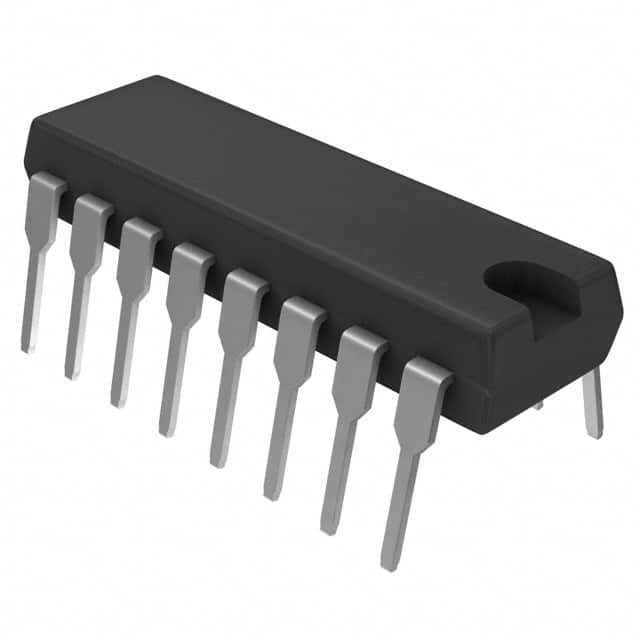Szczegóły produktu można znaleźć w specyfikacjach.

MM74C85N
Product Overview
- Category: Integrated Circuit
- Use: BCD-to-Seven Segment Decoder/Driver
- Characteristics: High-speed, low-power consumption, compact size
- Package: DIP (Dual In-line Package)
- Essence: Converts binary-coded decimal (BCD) input into a 7-segment display output
- Packaging/Quantity: Available in tubes of 25 units
Specifications
- Supply Voltage: 5V
- Input Current: 1.5mA (max)
- Output Current: 5mA (max)
- Operating Temperature Range: -40°C to +85°C
- Propagation Delay Time: 35ns (typical)
Detailed Pin Configuration
The MM74C85N has a total of 16 pins, which are assigned as follows:
- A0 - BCD Input A0
- A1 - BCD Input A1
- A2 - BCD Input A2
- A3 - BCD Input A3
- LT - Lamp Test Input
- BI/RBO - Blanking Input/ Ripple Blanking Output
- RBI - Ripple Blanking Input
- GND - Ground
- F - Seven Segment Output F
- E - Seven Segment Output E
- D - Seven Segment Output D
- C - Seven Segment Output C
- B - Seven Segment Output B
- A - Seven Segment Output A
- VCC - Positive Power Supply
- RBO - Ripple Blanking Output
Functional Features
The MM74C85N is designed to decode and drive a common-cathode 7-segment LED display. It accepts a 4-bit binary-coded decimal (BCD) input and generates the corresponding outputs to display the decimal digits 0-9. The lamp test input (LT) allows all segments to be turned on simultaneously for testing purposes. The blanking input (BI) and ripple blanking input (RBI) control the display's blanking and ripple blanking functions, respectively.
Advantages and Disadvantages
Advantages: - High-speed operation enables real-time display updates - Low-power consumption makes it suitable for battery-powered devices - Compact size saves board space in electronic designs
Disadvantages: - Limited to driving common-cathode 7-segment displays only - Requires additional components for multiplexing multiple displays
Working Principles
The MM74C85N uses a combination of logic gates and internal decoding circuits to convert the BCD input into the appropriate signals for driving the 7-segment display. Each segment of the display is controlled by a separate output pin, which can be individually activated or deactivated based on the input value. The inputs are decoded internally to determine the correct combination of outputs required to display the corresponding digit.
Detailed Application Field Plans
The MM74C85N is commonly used in various applications that require the conversion of BCD data into a 7-segment display output. Some typical application fields include:
- Digital Clocks: The MM74C85N can be used to drive the 7-segment display in digital clocks, allowing the display of hours, minutes, and seconds.
- Counters: It can be employed in counter circuits to display the count value in decimal format.
- Measurement Instruments: The IC can be utilized in measurement instruments such as multimeters or voltmeters to display the measured values accurately.
- Industrial Control Systems: The MM74C85N finds applications in industrial control systems where numerical data needs to be displayed.
Detailed and Complete Alternative Models
Some alternative models that serve similar functions to the MM74C85N are:
- CD4511: BCD-to-7 Segment Latch/Decoder/Driver
- SN74LS47: BCD-to-7 Segment Decoder/Driver with Open-Collector Outputs
- HEF4543B: BCD-to-7 Segment Latch/Decoder/Driver with Constant Current Source Outputs
These alternative models offer similar functionality and can be used as replacements for the MM74C85N in various applications.
Word count: 496 words
Wymień 10 typowych pytań i odpowiedzi związanych z zastosowaniem MM74C85N w rozwiązaniach technicznych
Sure! Here are 10 common questions and answers related to the application of MM74C85N in technical solutions:
Q: What is MM74C85N? A: MM74C85N is a 4-bit magnitude comparator integrated circuit (IC) commonly used in digital systems.
Q: What is the purpose of a magnitude comparator? A: A magnitude comparator compares two binary numbers and determines their relative magnitudes (greater than, less than, or equal).
Q: How many bits can MM74C85N compare? A: MM74C85N can compare two 4-bit binary numbers.
Q: What are the input and output pins of MM74C85N? A: The inputs are A0-A3 and B0-B3, representing the two 4-bit numbers to be compared. The outputs are A<B, A=B, and A>B.
Q: Can MM74C85N handle negative numbers? A: No, MM74C85N is designed for unsigned binary numbers only. It does not support negative numbers.
Q: What is the power supply voltage range for MM74C85N? A: MM74C85N typically operates with a power supply voltage range of 4.75V to 5.25V.
Q: What is the maximum operating frequency of MM74C85N? A: The maximum operating frequency of MM74C85N is typically around 25 MHz.
Q: Can MM74C85N be cascaded to compare larger numbers? A: Yes, multiple MM74C85N ICs can be cascaded together to compare larger binary numbers by connecting the carry-out (COUT) of one IC to the carry-in (CIN) of the next.
Q: What is the propagation delay of MM74C85N? A: The propagation delay of MM74C85N is typically around 20-30 nanoseconds.
Q: Can MM74C85N be used in microcontroller-based systems? A: Yes, MM74C85N can be used in microcontroller-based systems as a standalone component or as part of a larger digital circuit to compare binary numbers.
Please note that these answers are general and may vary depending on specific datasheet specifications and application requirements.

